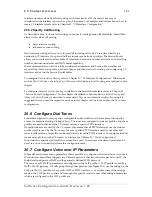
176
CS Context Overview
The job of the CS context and its associated components is to route and establish a voice call. For
example the signaling for dial-up circuits is routed and the corresponding voice call circuits are
switched between PSTN interfaces and via VoIP interfaces to the VoIP gateways and the IP Context.
This is explained in more detail in the configuration task 'Configure Call Routing'.
20.2 CS Context Configuration Task List
The information that is needed for the CS entity configuration is distributed among several
configuration tasks, depending on its logical content.
For example, all related information that pertains to call routing is described in configuration task
'Configure Call Routing'. These configuration steps themselves can be described in one or more other
chapters. Thus, to configure call routing you have to refer to Chapter 21, “CS Interface
Configuration” and Chapter 22, “Session Router Configuration”.
This chapter shows you the correlation between the several CS configuration components. We
recommend that you perform the CS context configuration in the order that is described below.
Many of the parameters have default values whichdo not need to be changed. This means, that you
generally do not need perform all of the described configuration tasks. In such cases it is stated in the
text that you can skip the respective configuration task. If you are unaware of the default values
refer to Chapter 16, “Context CS Mode” in the SmartWare
Command Reference Guide
.
•
Plan the CS Configuration
•
Configure General CS Settings
•
Configure Call Routing
•
Configure Dial Tones (Advanced)
•
Configure Voice Over IP Settings (Advanced)
•
Configure ISDN Ports
•
Configure an ISoIP VoIP Connection
•
Configure a H.323 VoIP Connection
•
Activate CS Context Configuration
20.3 Plan the CS Configuration
There are many possible policies and factors that may influence the CS context configuration. It
depends on what your application is and how your network is configured. Several factors to
consider for planning your CS configuration are listed below:
•
Application / Network Scenario
•
Peripheral devices, such as PBX or remote VoIP gateway.
•
VoIP protocol (ISoIP or H.323); gatekeeper settings in the case of H.323
•
Number and type of interface cards installed in your Smartnode(s)
•
Call routing
For an example see Figure 20-2, which depicts a remote office in an enterprise network. The example
concentrates on the SmartNode in the remote office. There is an ISDN phone, a personal computer, a
connection to the Public ISDN network and a connection to the IP backbone. The VoIP protocol used
is ISoIP with a codec G.711. A call is routed to the IP backbone as well as to the Public ISDN network
depending on its prefix and number length. This implies the following CS configuration:
•
Because we are connected to the Public Switched Telephone Network, we get the clock-
source from the corresponding ISDN port and simultaneously synchronize the system time
Software Configuration Guide, Revision 1.03
of the SmartNode to the ISDN time. (Described in section 'Configure General CS Settings').
In general, please be careful from which location you get your clock source. If your clock for
Summary of Contents for SmartWare R2.00
Page 2: ......
















































